Soparnik
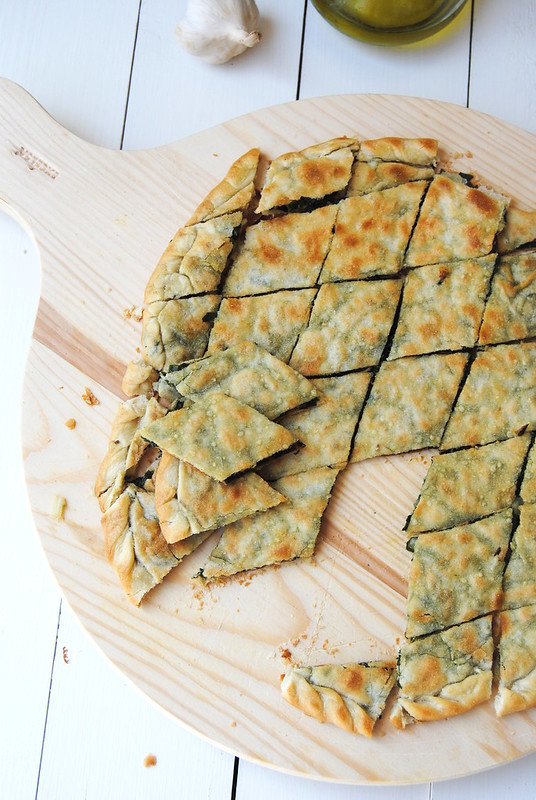 |
Soparnik is a savoury pie, consisting in two thin sheets of dough similar to filo dough, only slightly thicker, and a filling prepared with Swiss chard, onions and olive oil.
This simple and poor dish has become a cultural trademark and it's promoted by Poljički soparnik association and is considered an important cultural heritage of Croatia. The dish has its origins in Poljica region in Dalmatia, the area between the towns of Split and Omiš.
It was originally prepared during the winter months, when older Swiss chard was available. It is now available all year round and it's promoted by many local restaurants, events and festivals dedicated to this dish.
Below I'll share the recipe and advice as how to prepare it at home in a regular, home oven. But the particularity of this dish is also in the way it is baked traditionally. In the past all the houses in the area had an open fire hearth, called "komin". And the soparnik was (and still is) traditionally baked under embers and ashes on the hot base. Which certainly gives it a particular flavour, too. But we can recreate this delicious dish in all it's simplicity in our regular home ovens, too. Also, when baked on "komin", soparnik is usually much bigger than it could ever fit into your home oven. therefore, I prepared two smaller ones that could fit onto my baking stone.
However, if you happen to spend some time travelling to or staying on vacation in the area, don't miss the opportunity to taste the original one.
And here you can watch a video to see how it's prepared.
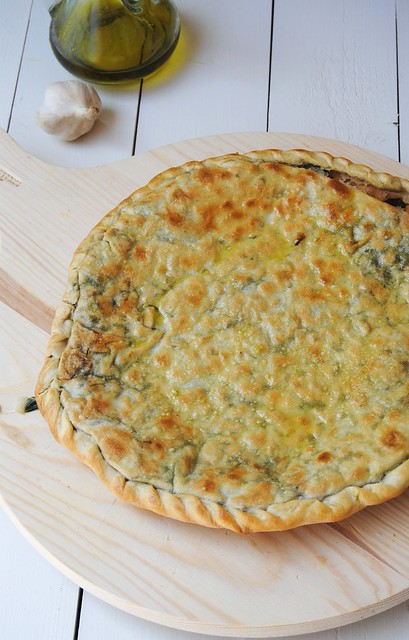 |
Soparnik
Dough:
* 300 g flour
* 25 g extra virgin olive oil
* 1/2 teaspoon salt
* about 170 g water
Filling:
* 250 g Swiss chard, only green part of the leaves, cut into strips
* 1 small onion or a couple scallions
* parsley
* salt
* extra virgin olive oil (1-2 TBspoons)

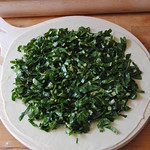
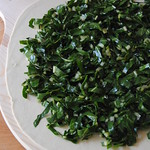

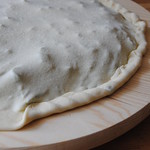
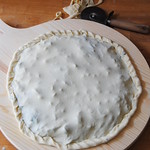
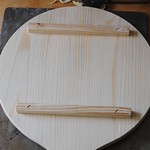

Sift the flour into a mixing bowl, add the salt, the oil and gradually add the water while mixing everything together. Knead the dough until soft and smooth. The dough should be neither too soft or too stiff. Work the dough well, the longer you knead it the more elastic it will be and easier to stretch.
Divide the dough into four pieces and shape each into a little ball. Cover them with an upturned mixing bowl and let rest at least 1/2 to 1 hour. The rest is important for the gluten to relax.
In the meantime, prepare the vegetables for the filling. Wash and dry carefully the Swiss chard leaves. Cut off the stems, you'll need the green part only. Cut the leaves into strips.
Finely chop the onion or scallion and add it to the Swiss chard, as well as some finely chopped parsley. Season with salt to taste and a good drizzle of extra virgin olive oil.
When the dough has rested, take the first two balls and roll each one very thin, 2 to 3 milimeters, using a rolling pin. Try to get more or less perfect circles.
Distribute half of the Swiss chard filling leaving an emty margin all around.
Cover the filling with the second, empty disc of dough you previously rolled out.
Trim the edges so they are even and fold the two layers together, upward, pinching them together.
Sprinkle the top with some corn meal (polenta) and a little coarse sea salt. Flip the soparnik so that the side you sprinkled with cornmeal is down (the easiest way to do it is following: In the first place, you should roll the first circle of the dough on a board/or an upturned baking sheet, fill it and cover with the second sheet of the dough, then place another baking sheet on top and flip them together. The lower side being well dusted with cornmeal should slide easily then onto the baking stone).
note: once you finished forming the first soparnik, proceed preparing the second one in the same way with the remaining dough and filling.
Preheat the oven to 250°C with the baking stone inside. When the oven and the baking stone are hot, slide the soparnik onto the stone. Lower the temperature immediately to 200-220°C and bake the soparnik for 15-20 minutes. Prick the dough with a fork a few times.
Once it's bake take the soparnik out of the oven and flip again, so that the side that was facing down while baking is up now. Brush with some extra virgin olive oil mixed with minced garlic, and let it cool down.
Once it's cool, cut it into rhombs and serve.
 |
Soparnik
Pasta:
* 300 g di farina tipo "0"
* 25 g di olio extravergine d'oliva
* 1/2 cucchiaino di sale
* circa 170 g di acqua
Ripieno:
* circa 250 g di bietole, pulite - solo la parte verde, tagliate a striscioline
* 1 cipolla piccola o qualche cipollotto
* prezzemolo
* sale
* olio exravergine d'oliva (1 o 2 cucchiai)
Setacciate la farina in una ciotola, aggiungete il sale e l'olio, e poi versate gradualmente l'acqua impastando. L'impasto non deve risultare ne troppo morbido ne troppo sodo, perché questo comprometterebbe la stesura. Lavorate l'impasto sulla spianatoia per almeno 10 minuti, finché risulti liscio ed elastico. Dividetelo in quattro parti uguali e formate quattro palline. Copritele con la ciotola rovesciata (a campana) e lasciate riposare almeno 1/2 ora o 1 ora. Il riposo è necessario per far si che il glutine si rilassi per permettere poi facile stesura dell'impasto.
Nel frattempo preparate il ripieno.
Lavate e asciugate accuratamente le bietole (e consigliabile scegliere le foglie più dure, non quelle giovani e delicate). Se non avete una centrifuga per l'insalata per asciugare le foglie, lavate le bietole la sera prima e stendetele su un telo.
Tagliate le bietole (rimuovete le coste, e usate solo la parte verde) in strisce sottili. Aggiungete la cipolla o cipollotti sminuzzati, e il prezzemolo tritato. Condite con il sale e l'olio extravergine d'oliva. Mescolate bene.
Prendete le prime due palline di impasto. Stendetele con un mattarello fino a ottenere una sfoglia sottile (spessa non più di 2 o 3 millimetri). Sistemate il primo disco su una pala o una teglia completamente piana o rovesciata. Distribuitevi sopra metà del ripieno di bietole lasciando il bordo vuoto tutto intorno.
Coprite il ripieno con la seconda sfoglia, ritagliate eventualmente il bordo, e poi piegatelo verso l'alto prendendo le due sfoglie insieme e pizzicandole.
Cospargete la superficie con la farina di mais (per polenta) e un po' di sale grosso. Poggiate un altra pala o teglia sopra e ribaltate tutto insieme in modo che la parte che prima era in alto e che avete cosparso con la farina di mais, sia adesso sotto.
nota: ripetere il procedimento con la pasta e ripieno rimasti per formare un secondo soparnik nello stesso modo.
Scaldate il forno a 250°C con la pietra refrattaria dentro (se non avete la pietra, scaldate una placca da forno.
Quando la pietra e il forno sono ben caldi, fate scivolare il soparnik sulla pietra, abbassate subito la temperatura a 200°-220°C e cuocetelo per 15-20 minuti. Appena notate che la sfoglia superiore inizia a gonfiarsi, bucherellatela con i rebbi di una forchetta. Soparnik è cotto quando è leggermente dorato sotto e sopra.
Sfornate il soparnik e ribaltatelo di nuovo. Con un pennello secco togliete prima la farina in eccesso, e poi spennellatelo bene con l'olio extravergine aromatizzato con l'aglio sminuzzato.
Lasciatelo intiepidire e poi tagliatelo in rombi e servite.
 |
Tijesto:
* 300 g brašna
* 25 g maslinovog ulja
* 1/2 žličice soli
* oko 170 g vode
Nadjev:
* 250 g blitve, očišćene (samo zeleni dio), narezane
* 1 manja glavica luka ili mladi luk
* peršin
* sol
* maslinovo ulje (1-2 žlice)
Prosijte brašno u zdjelu, dodajte sol, ulje i postepeno vodu, te umijesite srednje tvrdo tijesto. Ako je pretvrdo bit će teže razvaljati ga, ako je premekano također. Tijesto dobro izmijesite na dasci, jer što ga duže mijesite to će se bolje razviti gluten i bit će elastičnije i lakše za razvući. Podijelite tijesto na 4 jednaka komada, oblikujte od svakog lopticu i pokrijte ih preokrenutom zdjelom. Ostavite tijesto da odmara najmanje pola sata do sat da bi se gluten opustio, i da tijesto možete poslije rastanjiti.
U međuvremenu pripremite nadjev. Blitvu koju ste prethodno dobro oprali i posušili (ako nemate npr. centrifugu za salatu u kojoj možete posušiti listove, operite je večer prije i raširite pa ostavite da se dobro osuši preko noći) narežite na trakice (samo zeleni dio listova). Dodajte blitvi sitno nasjeckan luk i list peršina, posolite i pouljite pa dobro izmiješajte rukama.
Kad je tijesto odmorilo, uzmite prve dvije kuglice i svaku razvaljajte na krug (da budu jednake veličine) debljine ne više od 2 ili 3 milimetra, ne vukući tijesto kao za savijaču, već valjajući ga valjkom (oklagijom). Na prvi krug tijesta rasporedite polovicu pripremljenog nadjeva da bude u jednoličnom sloju. Ostavite prazan rub.
Pokrijte nadjev drugim dijelom tijesta. Ako je potrebno odrežite višak tijesta i zatim savijte rub prema gore tako da obuhvatite oba sloja, gornji i donji, i štipkate tijesto.
Pospite odozgor tijesto kukuruznim brašnom i malo krupne morske soli. Poklopite ga zatim plehom ili daskom pa preokrenite tako da je donja strana sad gore, a ona koju ste prethodno pobrašnili dolje.
Da bih pečenje u pećnici barem malo približila načinu pečenja na kominu, ja sam soparnik pekla na kamenu za kruh/pizzu. Kamen sam prvo dobro zagrijala, najmanje pola sata do 45 minuta na 250°C, a zatim soparnik prenijela i skliznula na njega (zato se pobrašnjeni dio okrene prema dolje, da soparnik lakše sklizne). Temperaturu smanjiti na 200-220°C i peći soparnik oko 15-20 minuta, treba lagano porumeniti dolje i gore. Kad primijetite da se gornja kora počne napuhavati zbog pare zarobljene unutra, probodite je na par mjesta vilicom.
Pečeni soparnik izvadite iz pećnice i opet okrenite tako je strana koja je u pečenju bila dolje sad opet gore.
Neka se ohladi par minuta a zatim četkicom uklonite višak brašna i premažite površinu mješavinom maslinovog ulja i usitnjenog češnjaka.
Izrežite soparnik na rombove i poslužite.
video
Izgleda fantastično! Ne mogu vjerovati da je tako divan ispao, a pečen je u pećnici.
ReplyDeleteHvala ti. Zasluga je sigurno i pečenje na kamenu
DeleteNapravila sam ga danas - pekla sam na rešetki pećnice. Okus fantastičan!
DeleteNon sono mai stata in Croazia, è da tanto che dico che voglio farci un giro. A prima vista sembra un po' l'erbazzone reggiano anche se molto più sottile e con la pasta molto più leggera. Deve essere delizioso gustato al tramonto fuori in giardino
ReplyDeletelooks wonderful great to share
ReplyDeletenikada nisme nešto takvo probala, ali jedva čekam, da pokušam ! hvala ti za recept :)
ReplyDelete